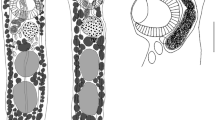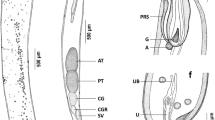Abstract
New morphological, molecular and ecological data for Ditrachybothridium macrocephalum Rees, 1959 (Cestoda: Diphyllidea) are presented and discussed based on specimens recovered from the blackmouth catshark Galeus melastomus Rafinesque (Scyliorhinidae) in the Western Mediterranean. A redescription of the plerocercus of this parasite is provided and new data on immature and mature worms including the first description of the eggs are reported, based on light and scanning electron microscopy observations. Analysis of 28S rDNA (domains D1–D3) sequences from plerocerci, immature and adult specimens revealed that they are conspecific with specimens from the North East Atlantic. Although previous authors considered that museum specimens identified as D. macrocephalum may represent more than one species, examination of type- and voucher material revealed no relevant morphological differences between museum specimens and the present material. Information on infection levels of D. macrocephalum is provided from a large number of host specimens (n = 170). This species was more abundant in juvenile than in adult hosts and on the middle slope than on the upper slope; this may be related to ontogenetic and bathymetric diet shifts of G. melastomus.




Similar content being viewed by others
References
Abbot, L. M., & Caira, J. N. (2014). Morphology meets molecules: a new genus and two new species of diphyllidean cestodes from the yellowspotted skate, Leucoraja wallacei, from South Africa. Journal of Parasitology, 100, 323–330.
Bray, R. A., & Olson, P. D. (2004). The plerocercus of Ditrachybothridium macrocephalum Rees, 1959 from two deep-sea elasmobranchs, with a molecular analysis of its position within the order Diphyllidea and a checklist of the hosts of larval diphyllideans. Systematic Parasitology, 59, 159–167.
Bush, A. O., Lafferty, K. D., Lotz, J. M., & Shostak, A. W. (1997). Parasitology meets ecology on its own terms: Margolis et al. revisited. Journal of Parasitology, 83, 575–583.
Caira, J. N., Marques, F. P. L., Jensen, K., Kuchta, R., & Ivanov, V. (2013). Phylogenetic analysis and reconfiguration of genera in the cestode order Diphyllidea. International Journal for Parasitology, 43, 621–639.
Carrassón, M., Stefanescu, C., & Cartes, J. E. (1992). Diets and bathymetric distributions of two bathyal sharks of the Catalan deep sea (western Mediterranean). Marine Ecology Progress Series, 82, 21–30.
Chervy, L. (2009). Unified terminology for cestode microtriches: a proposal from the International Workshops on Cestode Systematics in 2002–2008. Folia Parasitologica, 56, 199–230.
Constenla, M., Padrós, F., & Palenzuela, O. (2014). Endolimax piscium sp. nov. (Amoebozoa), causative agent of systemic granulomatous disease of cultured sole, Solea senegalensis Kaup. Journal of Fish Diseases, 37, 229–240.
D’Onghia, G., Politou, C.-Y., Bozzano, A., Lloris, D., Rotllant, G., Sion, L., & Mastrototaro, F. (2004). Deep-water fish assemblages in the Mediterranean Sea. Scientia Marina, 68, 87–99.
Darriba, D., Taboada, G., Doallo, R., & Posada, D. (2012). jModelTest 2: more models, new heuristics and parallel computing. Nature Methods, 9, 772.
Faliex, E., Tyler, G., & Euzet, L. (2000). A new species of Ditrachybothridium (Cestoda: Diphyllidea) from Galeus sp. (Selachii, Scyliorhinidae) from the south Pacific Ocean, with a revision of the diagnosis of the order, family, and genus and notes on descriptive terminology of microtriches. Journal of Parasitology, 86, 1078–1084.
Fyler, C. A., Caira, J. N., & Jensen, K. (2009). Five new species of Acanthobothrium (Cestoda: Tetraphyllidea) from an unusual species of Himantura (Rajiformes: Dasyatidae) from northern Australia. Folia Parasitologica, 56, 107–128.
Guindon, S., Dufayard, J.-F., Lefort, V., Anisimova, M., Hordijk, W., & Gascuel, O. (2010). New algorithms and methods to estimate maximum-likelihood phylogenies: assessing the performance of PhyML 3.0. Systematic Biology, 59, 307–321.
Guindon, S., & Gascuel, O. (2003). A simple, fast and accurate algorithm to estimate large phylogenies by maximum-likelihood. Systematic Biology, 52, 696–704.
Huelsenbeck, J. P., Ronquist, F., Nielsen, R., & Bollback, J. P. (2001). Bayesian inference of phylogeny and its impact on evolutionary biology. Science, 294, 2310–2314.
Isbert, W., Rodríguez-Cabello, C., Frutos, I., Preciado, I., Montero, F. E., & Pérez-del-Olmo, A. (2015). Metazoan parasite communities and diet of the velvet belly lantern shark Etmopterus spinax (Squaliformes: Etmopteridae) in the north-east Atlantic Ocean: a comparison of two deep-sea ecosystems off northern Spain. Journal of Fish Biology, 86, 687–706.
Kuchta, R., & Caira, J. N. (2010). Three new species of Echinobothrium (Cestoda: Diphyllidea) from Indo-Pacific stingrays of the genus Pastinachus (Rajiformes: Dasyatidae). Folia Parasitologica, 57, 185–196.
MacPherson, E. (1980). Regimen alimentaire de Galeus melastomus Rafinesque, 1810, Etmopterus spinax (L., 1758) et Scymnorhinus licha (Bonnaterre. 1788) en Méditerranée occidentale. Vie Milieu, 30, 139–148.
Poddubnaya, L., & Mackiewicz, J. S. (2009). Ultrastructure of the cirrus sac of echinophallid tapeworms (Cestoda, Bothriocephalidea) and the terminology of cirrus hard structures. International Journal for Parasitology, 39, 381–390.
Rees, G. (1959). Ditrachybothridium macrocephalum gen. nov., sp. nov., a cestode from some elasmobranch fishes. Parasitology, 49, 191–209.
Ronquist, F., Teslenko, M., van der Mark, P., Ayres, D. L., Darling, A., Höhna, S., Larget, B., Liu, l., Suchard, M. A., & Huelsenbeck, J. P. (2012). MrBayes 3.2: Efficient Bayesian phylogenetic inference and model choice across a large model space. Systematic Biology, 61, 539.
Scholz, T., & Hanzelová, V. (1998). Tapeworms of the genus Proteocephalus Weinland, 1858 (Cestoda: Proteocephalidae), parasites of fishes of Europe. Studie AV CR 2/98. Praha: Academia, 118 pp.
Tamura, K., Stecher, G., & Peterson, D. (2013). MEGA6: Molecular Evolutionary Genetics Analysis Version 6.0. Molecular Biology and Evolution, 30, 2725–2729.
Tyler, G. A. (2006). Tapeworms of Elasmobranchs (Part II). A monograph on the Diphyllidea (Platyhelminthes, Cestoda). Bulletin of the University of Nebraska State Museum, 20, 1–142.
Venes, D. (2001). Taber’s Cyclopedic Medical Dictionary (20th Edn). Philadelphia: F. A. Davis Company, 2654 pp.
Williams, H. H. (1960). A list of parasitic worms including 22 new records, from marine fishes caught off the British Isles. Annals and Magazine of Natural History, 2, 705–715.
Acknowledgements
We thank anonymous reviewers for their comments and suggestions. We are indebted to Dr Rodney A. Bray and Mrs. Eileen Harris (Natural History Museum, London, UK) for making the museum material available for examination. We also acknowledge Dr Aneta Kostadinova (Institute of Parasitology, Biology Centre of the Czech Academy of Sciences, Czech Republic) for her comments on the manuscript, Professor Janine Caira (University of Connecticut, USA) and Dr Veronica Ivanov (Universidad de Buenos Aires, Argentina) for their useful comments on morphological features of the specimens and Dr María Constenla and Mr. D. Pérez (both from Universitat Autònoma de Barcelona, Spain) for their help in obtaining fresh material.
Funding
This study was funded by the Spanish Ministry of Science and Innovation (MICI NN) project ANTROMARE (CT M2009–12214–C02–02) and partially supported by the Czech Science Foundation (project ECIP P505/12/G112) and the Prometeo/2011/040 project of the Generalitat Valenciana. SD benefits from a PIF PhD student grant of the Universitat Autònoma de Barcelona.
Conflict of interest
The authors declare that they have no conflict of interest.
Compliance with ethical standards
All applicable institutional, national and international guidelines for the care and use of animals were followed.
Author information
Authors and Affiliations
Corresponding author
Additional information
Sara Dallarés and Ana Pérez-del-Olmo contributed equally towards this study.
Rights and permissions
About this article
Cite this article
Dallarés, S., Pérez-del-Olmo, A., Carrassón, M. et al. Morphological and molecular characterisation of Ditrachybothridium macrocephalum Rees, 1959 (Cestoda: Diphyllidea) from Galeus melastomus Rafinesque in the Western Mediterranean. Syst Parasitol 92, 45–55 (2015). https://doi.org/10.1007/s11230-015-9586-8
Received:
Accepted:
Published:
Issue Date:
DOI: https://doi.org/10.1007/s11230-015-9586-8




